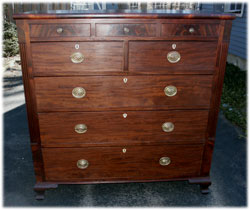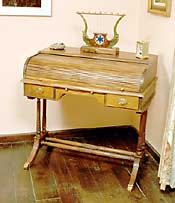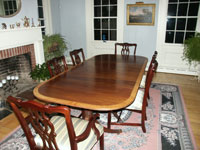|
|
The "New" Concise History is under construction here. Please bear with us as we improve our educational sections.
A Concise History of American Period Furniture
By Stanley D. Saperstein
Introduction
Jacobean | William & Mary | Queen Anne | Georgian | Chippendale | Hepplewhite | Adam | Sheraton | Federal | Victorian | Country | Gothic | Arts & Crafts
Summary
Federal, 1795-1830
 The Federal period, or American Empire, was the first totally distinct American period. The credit for this goes to America's first great furniture designer, Duncan Phyfe. Some people talk only about Duncan Phyfe when Federal furniture is spoken of, and some feel that the whole period should be named for him. The Federal period, or American Empire, was the first totally distinct American period. The credit for this goes to America's first great furniture designer, Duncan Phyfe. Some people talk only about Duncan Phyfe when Federal furniture is spoken of, and some feel that the whole period should be named for him.
 The period is broken into two sections: Early Duncan Phyfe, or Federal, and Late Duncan Phyfe, or American Empire. Phyfe took his early inspiration from Hepplewhite, Sheraton, and Adam, yet he gave his own distinctive style to his furniture and can be identified by the lyre design. The lines were a good combination of strait and curved. Decoration included light carving, turning, fluting, reeding, acanthus, cornucopias, oak leaves, palm and laurel, wheat, and swags. Mahogany was the only wood used, with silks, satin, brocade, wool, and horsehair for upholstering. The period is broken into two sections: Early Duncan Phyfe, or Federal, and Late Duncan Phyfe, or American Empire. Phyfe took his early inspiration from Hepplewhite, Sheraton, and Adam, yet he gave his own distinctive style to his furniture and can be identified by the lyre design. The lines were a good combination of strait and curved. Decoration included light carving, turning, fluting, reeding, acanthus, cornucopias, oak leaves, palm and laurel, wheat, and swags. Mahogany was the only wood used, with silks, satin, brocade, wool, and horsehair for upholstering.
 Phyfe's chairs use X-crossed legs and show Pomperian influence. Late Phyfe picks up the French Empire Style, but he made the furniture heavier and sturdier. Claw and bracket feet and heavy pedestal tables became very popular. Metal mounts are used extensively, and some oak, ash, hickory, and fruitwood are used, mahogany still predominating. Phyfe's chairs use X-crossed legs and show Pomperian influence. Late Phyfe picks up the French Empire Style, but he made the furniture heavier and sturdier. Claw and bracket feet and heavy pedestal tables became very popular. Metal mounts are used extensively, and some oak, ash, hickory, and fruitwood are used, mahogany still predominating.
TheConciseHistoryofEarlyAmericanFurniture.PDF
Download a PDF Version of The Concise History
|





